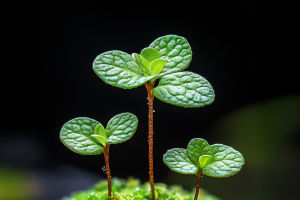The Hidden Internet of Roots
Walk through a forest and you'll see trees standing like individuals, each rooted in its own patch of soil. But beneath the surface, something unexpected is happening. Those roots aren't isolated.
They're part of an underground network powered by fungi—tiny threads that link plant to plant. Some scientists even call it the "wood wide web." And it's changing the way we think about forests, fields, and even our own gardens.
Fungi as connectors
At the heart of this network are mycorrhizal fungi. These fungi don't just sit on roots—they weave themselves inside and around them, extending far into the soil. To the plant, they act like extra root systems, pulling in water and minerals from places roots can't reach. In exchange, the plant offers sugars made through photosynthesis.
This trade alone is impressive. But the story gets better: once fungi connect two or more plants, they don't just swap food. They also pass signals, creating channels of communication underground.
What plants say underground
You might wonder—what could one plant possibly need to "say" to another? Quite a lot, it turns out.
1. Sharing nutrients: In shaded areas, smaller plants often get fewer resources. Through fungal links, taller trees sometimes send carbon to their struggling neighbors, helping them survive.
2. Sending alarms: When a plant is attacked by pests, chemical warning signals can travel through fungi to nearby plants. Those neighbors then boost their defenses before danger arrives.
3. Balancing communities: Certain species appear to share more with relatives, or even with seedlings growing in their shadow, giving the next generation a better start.
It's not exactly kindness—plants don't act out of compassion the way humans do. But the result is cooperation, a system that stabilizes entire ecosystems.
Winners, losers, and balance
Not all exchanges are equal. Some plants benefit more than others, and some even take advantage of the system. For example, orchids are known to tap into fungal networks early in life, drawing in resources before they're able to photosynthesize much on their own. Other plants may receive nutrients without giving much back.
This push and pull makes fungal networks feel less like a utopia and more like a bustling economy—some plants give generously, others take strategically, but overall the system keeps moving.
Lessons for farming and gardening
What's fascinating is that we can actually apply these insights above ground.
1. Gardeners who avoid disturbing the soil too often often see stronger fungal networks develop, which helps their plants grow healthier without as much fertilizer.
2. Farmers are experimenting with cover crops that encourage beneficial fungi, improving nutrient sharing between different plants in a field.
3. Studies show that crops with access to fungal partners often resist drought better, since the network helps pull water from deep or distant soil pockets.
Instead of thinking about plants as isolated units, it helps to think about them as members of a community—with fungi as the messengers holding it all together.
A different way of seeing forests
Next time you stand in a patch of woods, try to imagine what's happening beneath your feet. A giant oak may be feeding carbon to seedlings nearby. A stressed shrub may be whispering chemical warnings to its neighbors. Fungal threads thinner than human hair are carrying these signals silently through the dark soil.
Forests look still and quiet to us, but their roots are alive with transactions, alerts, and exchanges. It's a hidden world of cooperation and competition playing out under every step you take.
A quiet reminder for us
We often think survival is about standing alone—about being the strongest or tallest. But plants remind us that strength can come from connection. A single tree can weather storms, but a forest bound by fungal threads weathers them better.
Maybe that's the real secret of the underground network: life thrives when it's shared. Even in silence, even in darkness, roots and fungi prove that communication is everywhere. And if we learn to listen, it might just change the way we see the ground beneath us.
Copyright © zogu 2021 - 2025. All Right Reserved.


